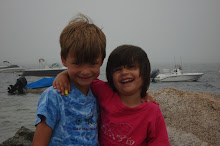
The story is due this week on finding the right helicopter to land on your mega-yacht. (I sh*t you not. That is the subject.)
With luck, the phone will ring at 6 a.m. tomorrow and on the other end will be someone calling from London who helps advise the ultra high-net-worth types about such a purchase, and he will rattle off the names of several helicopters. (We hope they are pretty, because that's what the editor wants. Pretty, pretty 'copters to put on the spreads, like pin ups. You know, a petite little Robinson or Eurocopter next to a lusty, power-hungry Agusta, and a big-boned Sikorsky dominatrix right next to a seasoned but saucy Bell. You know? Maybe you don't. I'm a little ashamed that I do.) This guy, if he calls, will also give me the phone number of a pilot who is now working off a yacht in the Bahamas, and who might have more details. I'm hoping for a cockney accent, or something from the north, but what are the odds? In the US when you talk to a pilot he's almost always southern, with the accent to match. Usually deep Texas, sometimes Georgia. The Carolinas are common, too. That or he affects a southern accent because all the swaggering types in aviation are southern. It's the cool thing to be. Not so sure what the deal is in England. So far the accents are pretty posh.
Sikorsky, a manufacturer, calls the day after that--we hope. No guarantees that these folks will keep their appointments. Sometimes people just don't call.
At that point, I'll need to make an outline for the story, the first of several. I always start with a rough outline, the type you can put on a cocktail napkin. I use three to five bullet points, plus a lead and a conclusion. In the cocktail napkin outline, I cheat on the lead (the beginning) and the conclusion. I use the most interesting anecdote in my notes as the lead and the second most interesting anecdote as conclusion. Sometimes this outline sticks all the way through to the final draft. Usually it changes. Making this outline, though, means that the story is almost done. The story has already been created in the reporting, in the conversations that happen around the story. The writing is just glorified typing. I don't mean that it's bad writing. It can't be bad. The sentences must all be correct and clear, but also unadorned.
Then I fill in all the quotes an anecdotes into an expanded outline. Then I pare them down. Get rid of repetitive information. They I have to look for missing pieces, in this case probably prices and other stats. An S-76 costs how much? ($10 to $12 million.) What's the span of the rotor blades? What's its range? How many can it seat? What's the waiting list for taking delivery? Stuff like that, easy to find, but it takes time. That expanded outline can become a draft in a couple of hours.






1 comment:
This is great--I like to read about your process. . .
Thanks for my bday wishes!
Post a Comment